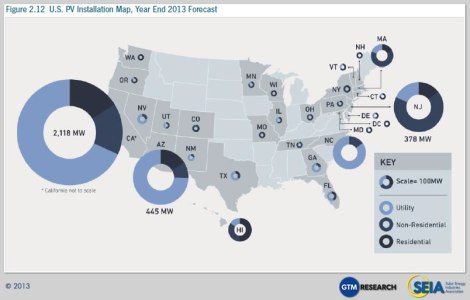
ShutterstockThe sun always shines in Los Angeles — and soon more residents will be able to take advantage of that fact.
No rooftop? No yard? No problem!
All Californians will be able to invest in solar and wind projects to reduce their power costs and their carbon footprints under a bill awaiting Gov. Jerry Brown’s (D) signature.
“SB 43 will allow the millions of Californians who cannot install their own solar unit, windmill, or other renewable power generation system to obtain renewable energy through their utility,” said one of the bill’s authors, state Sen. Lois Wolk (D).
The legislation establishes the largest shared renewables program in the U.S. The Daily Democrat explains:
SB 43 establishes the Green Tariff Shared Renewables Program, a 600 Megawatt statewide program that will allow the customers of investor-owned utilities — including local governments, businesses, schools, homeowners, municipal customers, and renters — to purchase up to 100 percent of their electricity from a renewable energy facility. The program would sunset in 2019.
Among those to benefit from SB 43 would be the state’s millions of renters as well as business owners who lease their stores or offices. The bill will also provide access to disadvantaged communities disproportionately affected by environmental pollution and other hazards that can harm the public’s health — as well as homeowners unable to finance installation of a renewable power generation system.
The bill comfortably passed both chambers of California’s legislature last week, and Brown is expected to sign it into law.
Passage of separate legislation last week means that it isn’t just going to get easier for Californians to buy solar power — it’s going to get easier for them to sell it.
The lawmakers sent a separate bill to Brown that would ease the way for citizens to sell their excess solar power (and other types of renewable energy) onto the grid. AB 327 caps the monthly charge for customers participating in a so-called net-metering program at $10. It also increases the amount of renewable power that state regulators can compel the utilities to buy from their customers.
The votes again demonstrated the Golden State’s leadership on solar energy. California is a hub for the industry, and solar installations continued to grow in the second quarter of this year despite shrinking funds available through a state incentive program. From a report published last week by the Solar Energy Industries Association:
California’s PV market has seen continued growth amidst the dwindling incentives offered by the California Solar Initiative. Q2 2013 ranks as the strongest second quarter in the state’s history, with installations up 78% in the residential market and 26% in the non-residential market year-over-year. For residential and non-residential projects, higher retail rates have enabled project developers to secure a growing number of customers based purely on net metering (NEM), the federal 30% Investment Tax Credit, and accelerated depreciation. …
In the second half of 2013, our highest expectations for growth lie in the California and Arizona residential markets and in the California, Massachusetts and New York commercial markets.

SEIAClick to embiggen.

